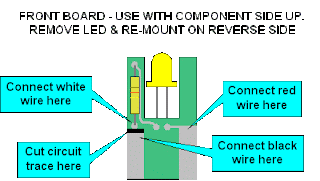The Precision Craft E8 is designed like a scaled down HO engine because it uses wires from the trucks, motor, and LED headlight that all plug into a circuit board. The board also has an 8 pin connector that either has a decoder or jumper wires if it has no decoder. I recalled that what I had done was to cut the jumpers on the original plug and then to solder the wires of a DZ125 decoder to the pins.
Here is a stock picture of a decoder like so you can get an idea of what this looks like.
This plug arrangement came in handy when troubleshooting this problem as I did not even have to turn on the soldering iron. After first verifying that the locomotive indeed did cause a short of the DCC system as soon as it was on the track, I began to unplug things.
- Unplugged the decoder, still got a short.
- Unplugged the motor, still got a short.
- Unplugged the rear truck, still got a short.
- Unplugged the front truck, still got a short.
First I checked the wheel gauge with an NMRA N scale standards gauge and it was OK. Then pulling the wheels out from each side I could see that the pins that come off the wheels and insert into the plastic tube part were long enough for the ends to touch inside the plastic tube part. I then took a bit off the end of one of the axle of one of the wheels with a Dermal tool cutoff wheel and that solved this problem.
Almost all N scale locomotive axle assemblies look like the photo at left. Two solid metal wheels with metal axle pins that insert into the ends of a plastic tube that has a gear.
It is easy to see how this could happen on any locomotive when the total length of the two metal axle pins are longer than the length of the plastic tube.
I would suspect that this could happen after someone pressed the wheels together to correct the wheel gauge. The owner of this engine said it started after the engine had derailed. I suspect that the ends of the 2 axle pins were already very close to touching and getting bumped by the derailment was just enough to make them short. This ended up being one of those very unusual problems that I though was worth sharing. I was relieved that the problem had nothing to do with my workmanship and the owner of the locomotive was relieved that the decoder was not burned out.














